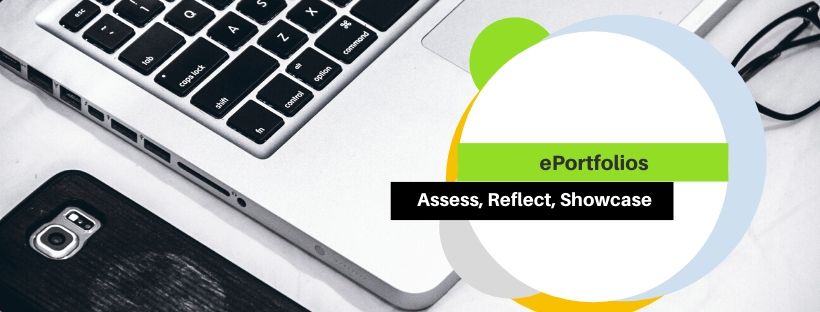ePortfolio

HIPs stands for High-impact Practices. According to the CSUSB, the benefits of HIPs are the “transformative influence on students’ personal development and educational growth; improve the quality of students’ experience, learning, retention, and success. ePortfolios are one of the more recently recognized HIPs, and are electronic representation of cumulative knowledge and the evolution of work."
Electronic portfolios (ePortfolios) "are electronic representations of what students know and can do" (Watson, Kuh, Rhodes, Light, & Chen, 2016). (Thompson, p.183)
Unlike other HIPs, ePortfolios can be implemented within a course or throughout a program. Ideally, an ePortfolio would want to be implemented at the program level and in partnership with other instructors in the program or college. "ePortfolios may be the most impactful [because of the ability] to connect and amplify the power of other HIPs" (Thompson, p. 183). Collaborating among courses to implement ePortfolios throughout a program is the most effective way to implement an ePortfolio and allows you to implement another HIP; Common Intellectual Experiences. The use of the same ePortfolio platform throughout the student’s college experience allows you to achieve another HIPs, thus magnifying the learning experience. This is one example of how an “ePortfolio is a nexus for other HIPs and is employed as a mega-HIP, connecting and amplifying other HIPs” (Linder & Hayes 2018).
There are two primary types of ePortfolios; a Showcase or Career Portfolio and an Assessment Portfolio. The Showcase or Career Portfolio displays the best work a student has created and is best suited for seeking employment. Artifacts of this form of portfolio are shared with prospective employers and further graduate opportunities. An Assessment Portfolio is meant to show the evolution of the student’s learning. Often, the Assessment Portfolio artifacts are shared only with the instructor or in peer-to-peer activities.
What makes an ePortfolio an effective High-impact Practice?
ePortfolios are comprised of the following ingredients to be effective HIPs:
· Student-owned space
· Peer engagement and feedback
· Creating online communities
· Allow for authentic assessment
Student-owned Space
Normally, learning is housed solely within a learning management system (LMS), and online course content can be copied over for reuse from the previous semester. This can sometimes prevent updates to course content and activities from occurring as frequently as needed. ePortfolios provide a unique solution to this problem of updating activities associated with the content. By existing outside of the LMS, students are able to develop digital literacy skills. These digital literacy skills include curating content, developing content for an audience, building themes, incorporating elements of design, and implementing concepts of ethical literacy, all associated with the course activity. This high order of thinking, "creating," helps the online course from becoming quickly stagnant.
Most importantly, students have the opportunity to take the ePortfolio with them through a platform that allows them to build content they own and grow in their career. The basic platforms for ePortfolio development are free website platforms such as WordPress or Wix. Other platforms, such as Portfolium and LinkedIn, provide the community aspect of social networking and online communities.
Peer Engagement and Feedback
The ePortfolio's various levels of online community are powerful due to the ability for students to engage in peer engagement and feedback. This ingredient is ideal for Assessment Portfolios. LMSs are often closed or secure systems, and the issue of FERPA should always be under consideration. However, allowing students to make their ePortfolios public for peers to engage in connective learning and feedback helps them develop a collaborative evolution for the work. The students are able to see the evolution and growth of each other and present this to the public.
Creating Online Communities
The use of an online community occurs at various levels: between students in a course, between students in the institution, between students in another institution, between students in another institution in the same type of course, and between students and experts in the field. Selecting a platform that allows this interaction among students to occur is not limited to an LMS. ePortfolio platforms like Portoflium and LinkedIn are convenient tools to allow for social interaction. Portfolium allows students to share their work and for feedback to occur on the artifacts and within a newsfeed. LinkedIn allows for groups and learning communities to be created and/or joined. These online communities allow students to reflect, engage in deeper learning, and engage in social pedagogy. (Thompson, p.188)
Authentic Assessment
The growth and evolution of the student's ePortfolio is dependent on authentic ways of assessing the portfolio. Projects are meant to be real and genuine examples of work. Instructors can work collaboratively with other instructors in the program to align learning objectives when implementing projects across and within individual courses. This way, students will always show continuity of components and elements within their ePortfolios. Below are two lists to help you grasp the components and elements of ePortfolios.
Components of an ePortfolio
· Biography
· Educational background
· Professional Experience
· Performance and skills
· Evidence of competencies (artifacts)
· Journals/Reflections
· Awards and Honors
Other elemental considerations:
· Audience
· Theme
· Composition
· Ethical literacy
· Digital Platform
Auburn University ePortfolio Project Student Resources provides detailed web page examining various elements for students to develop a web page, and be on the lookout for resources being developed here at VSU.
Please contact an Instructional Designer with The Center for eLearning to discuss how to incorporate ePortfolios into your course and/or program.
ePortfolio Sites
The following are sites are ePortfolios that will allow students to display their work:
Portfolium https://portfolium.com/ (Free to students)
Digication https://www.digication.com/(Fee for Student and Instructor)
Foliotek https://www.foliotek.com/(Fee for student)
LinkedIn https://www.linkedin.com/(Free)
WordPress with blog (Free with ads, Fee for own URL)
Wix with blog (Free with ads, Fee for own URL)
Waklet https://wakelet.com/home(Free)
Sites worth visiting:
Center for eLearning
-
Converse Hall
Suite 3200
Email Address
blazeview@valdosta.edu -
Mailing Address
1500 N. Patterson St.
Valdosta, GA 31698 - Phone: 229.245.6490
Office Hours
Monday - Friday
8 AM - 5 PM